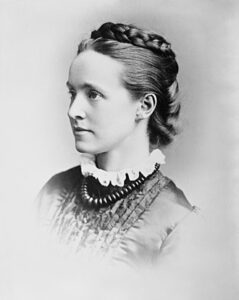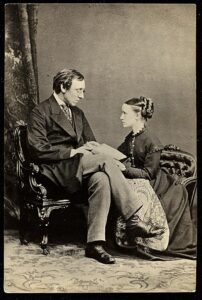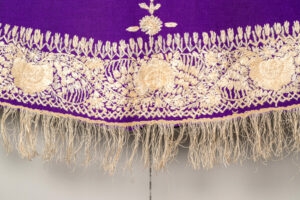Home » Collections showcase » Millicent Fawcett’s cape
Charlotte Fawcett donated this embroidered wool cape to Salisbury Museum in 1934. It is thought to have belonged to her aunt, Millicent Fawcett, who was a women’s suffrage campaigner.
The iconic colours of the British women’s suffrage movement were purple, white and green.
Millicent was a suffrage campaigner, becoming the leader of the NUWSS, National Union of Women’s Suffrage Societies, and frequently lecturing on behalf of the women’s movement.
She advocated for women’s right to vote, helping to petition parliament on the issue. Millicent became a successful author and essayist, writing Political Economy for Beginners (1870) and contributing to Essays and Lectures on Social and Political Subjects (1872).
Millicent’s husband, Henry Fawcett, was born in Salisbury in 1833. He was also a prominent activist for equal rights, and while campaigning met Elizabeth Garrett, Millicent’s older sister. He proposed to her but she rejected him. He went on to marry Millicent in 1867.
Millicent and Henry often visited Henry’s parents, who lived near the museum. When Henry died in 1884, Millicent continued to campaign for equality.
Millicent Fawcett backed countless campaigns, not just for women’s rights to vote, but also regarding women’s sexual health, social injustice and child abuse. She was made a Dame in 1925.
Millicent died in 1929, but lived to see the bill which allowed women over 21 to vote – it had been passed the previous year.
Millicent Fawcett campaigned for many aspects of women’s rights. In the video below, student Annabelle outlines how the cape could be used for inspiring Key Stage 3 & 4 History and PSHE lessons. Please note video contains discussion of sexual health matters suitable only for children aged 14 and up.



| Cookie | Duration | Description |
|---|---|---|
| cookielawinfo-checkbox-analytics | 11 months | This cookie is set by GDPR Cookie Consent plugin. The cookie is used to store the user consent for the cookies in the category "Analytics". |
| cookielawinfo-checkbox-functional | 11 months | The cookie is set by GDPR cookie consent to record the user consent for the cookies in the category "Functional". |
| cookielawinfo-checkbox-necessary | 11 months | This cookie is set by GDPR Cookie Consent plugin. The cookies is used to store the user consent for the cookies in the category "Necessary". |
| cookielawinfo-checkbox-others | 11 months | This cookie is set by GDPR Cookie Consent plugin. The cookie is used to store the user consent for the cookies in the category "Other. |
| cookielawinfo-checkbox-performance | 11 months | This cookie is set by GDPR Cookie Consent plugin. The cookie is used to store the user consent for the cookies in the category "Performance". |
| viewed_cookie_policy | 11 months | The cookie is set by the GDPR Cookie Consent plugin and is used to store whether or not user has consented to the use of cookies. It does not store any personal data. |

Males great bustards perform spectacular courtship displays, gathering at a ‘lek’ or small display ground to try to impress the females.
The great bustard has a dignified slow walk but tends to run when disturbed, rather than fly.
The hen-bird on display at The Salisbury Museum was one of the last great bustards to be eaten in the town!